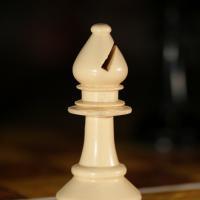
How Bad is a Bad Bishop?
There is much talk about ‘good’ and ‘bad’ bishops in the chess world. When a chess player thinks about a ‘bad’ bishop, he imagines the bishop blocked behind pawns without operational space and resembling a rather big pawn. The common stereotype is that if the pawns are located on the same color as a bishop then one should trade the bishop-- to get rid of a bad piece. In many cases it is so, but there are times when such a bishop is a good piece. The following examples show the second case.
With the last move of 18…Bc8 black posted a question for white: to trade bishops or not? White has five pawns on white squares, and the white squares of d5 and f5 are under control. Black has queenside pawns on dark squares, and weak white squares: it seems that the bishop on b7 was well placed to defend those squares. Retreating white's bishop to g2 would make him a ‘bad’ bishop since it would be locked by the pawn chain f3-e4.
The next example is from the same category. White has pawns on dark squares and Bc2 is the piece that protects the weakened light squares. Black has all the queenside pawns on white squares, which limits Bb5. Thus exchanging light-squared bishop should favor black, right? Lets look at specific lines again.
The third example shows how a ‘bad’ bishop performs an important task in a position. Bb7 is buried behind pawns a6-b5-c6, and it cannot leave its position for a more active one, since it is the protector of c6 and a6. The c5 break would activate it but black would lose a pawn this way. On the other hand there is no clear way to break into black’s position. White finds a brilliant solution:
The last example is from recent play. White has an option of trading light-squared bishops and playing f3-e4 or playing f3-e4 right away. Lets hear what former World Champion Kramnik has to say about this position: “Now I no longer want to exchange bishops, but rather play e4 and later f4, and the queen on a8 will not feel very comfortable with such a bishop on g2.” In this case, Bg2, even behind the pawn chain of f3-e4, is not a bad bishop, since it defends the king and targets the black queen.






